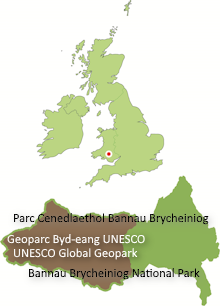The area around Pontneddfechan at the head of the Vale of Neath is one of very few in the world where sandstone has been extensively worked in underground mines. But then this is a very special sort of sandstone.
Silica Rock
In the steep walls of the gorges of the Nedd Fechan, the Afon Mellte and the Sychryd are exposed beds of a very hard and pure sandstone which have come to be known as ‘the silica rock’. It is in fact the lowermost of a whole family of such beds which collectively are termed the ‘Millstone Grit’ – a gritstone is simply a sandstone formed from coarse angular grains of quartz or ‘silica’.
It is the purity of these rocks – almost 100% silica (SiO2) – that made them a target for miners from the 18th to the 20th century. The burgeoning industries of industrial South Wales needed large numbers of heat-resistant bricks to line the furnaces in which copper and iron-smelting took place. Only bricks made from more or less pure silica could stand the intense temperatures without shattering.
The silica rock was worked through a series of adits – horizontal mine passages driven into the side of the hill – both behind Craig-y-ddinas and on either side of the Nedd Fechan upstream of Pontneddfechan.
In both cases tramways were forced through difficult terrain to these mine entrances to permit horse-drawn drams to take away the rock to the brick works. An early factory was built by Messrs Frederick and Jenner at Dinas Bridge and a works was later established at Pont Walby near Glyn-neath.
The Nedd Fechan mines
The tramway up the Nedd Fechan gorge now gives ready access to walkers. Some of the original stones can be seen in the path surface, each with its two holes into which pins were driven to hold the tramway plates. Three adits can be seen beside the path on the west bank of the Nedd Fechan. The abutments of three bridges which once took tramways to further adits on the eastern side of the river can still be seen by the observant walker.
The largest mine beside the Nedd Fechan was at Cwm Gored (OS grid ref SN 899087) where the ruins of a number of buildings still stand amongst the trees. Keep clear of their potentially unstable walls and do not attempt to enter any mine entrances.
The tramway from this and other mines ran down to the Angel Inn, directly in front of what is now Sgwd Gwladys Lodge and then beside the modern ‘B’ road to Glyn-neath.
- NEW! ‘Fossils & Firebricks’ – listen to downloadable stories of the Nedd Fechan silica mines.
Dinas Rock Silica Mines
The mines behind Dinas Rock were a rather larger affair than their cousins alongside the Nedd Fechan. Several large entrances are still clearly visible from the path which drops steeply down from the top of Dinas Rock to the Sychryd.
Note that although they are situated on what is now Natural Resources Wales access land, none of the mine entrances should be entered due to the danger of rockfall. Natural Amenities Ltd own the mineral rights in the area between the Sychryd and the Mellte and Hepste rivers and hence the mines themselves.
The underground galleries were very extensive, extending over an area some 1000m x 500m. Parts of the mine are now flooded, others will have become unstable.
The material was transported by a series of tramways and inclines and indeed overhead cables suspended on pylons, down to the valley floor and then onward to the Pont Walby brickworks. The former tramway along the southern side of the Afon Mellte from Dinas Rock to Pontwalby is a modern-day bridleway which allows the route to be traced on foot or pushbike.
In later days the material was taken to a brickworks at Swansea until the whole operation closed down in the 1960s.



